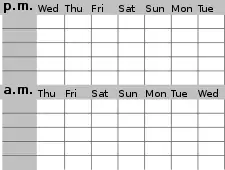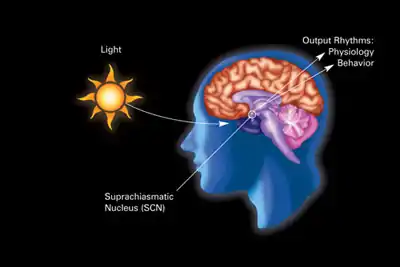Irregular sleep–wake rhythm
Irregular sleep–wake rhythm is a rare form of circadian rhythm sleep disorder. It is characterized by numerous naps throughout the 24-hour period, no main nighttime sleep episode and irregularity from day to day.[2] Sufferers have no pattern of when they are awake or asleep, may have poor quality sleep, and often may be very sleepy while they are awake. The total time asleep per 24 hours is normal for the person's age.[3][4][5] The disorder is serious—an invisible disability. It can create social, familial, and work problems, making it hard for a person to maintain relationships and responsibilities, and may make a person home-bound and isolated.
| Irregular Sleep Wake Rhythm Type | |
|---|---|
| Other names | Circadian rhythm sleep disorder - irregular sleep-wake type[1] |
| Specialty | Neurology |
Causes
ISWD has various causes, including neurological disorders such as dementia (particularly Alzheimer's Disease), brain damage, or intellectual disabilities.[6] It is thought that sufferers have a weak circadian clock.[4][5] The risk for the disorder increases with age, but only due to increased prevalence of co-morbid medical disorders.[6]
Diagnosis

A sleep diary should be kept to aid in diagnosis and for chronicling the sleep schedule during treatment. Other ways to monitor the sleep schedule are actigraphy[4][5] or use of a Continuous Positive Airway Pressure (CPAP) machine that can log sleeping times
The following are possible warning signs:
- sleeping off and on in a series of naps during the day and at night, with no regular pattern but with normal total sleep time,
- difficulty getting restorative sleep, and
- excessive daytime sleepiness.[4][5]
Because of the changes in sleep/wake time, and because this is a rare disorder, initially it can seem like another circadian rhythm sleep disorder such as non-24-hour sleep–wake disorder or like insomnia.
Initial visit with sleep physician
A physician specializing in sleep medicine may ask patients about their medical history; for example: neurological problems, prescription or non-prescription medications taken, alcohol use, family history, and any other sleep problems. A thorough medical and neurological exam is indicated. The patient will be asked to complete a sleep diary, recording natural sleep and wake up times, over several weeks. Sleep rating with the Epworth Sleepiness Scale may be used.[4][5]
Medical testing
A neurological condition or another medical problem may be suspected, in which case, blood tests, a CT scan or an MRI may be used. An overnight sleep study is usually not needed to detect this disorder, but may be indicated if other sleep disorders, such as sleep apnea and periodic limb movement disorder, seem likely. The overnight sleep study is called polysomnography. It charts brain waves, heart beat, muscle activity, and breathing during sleep. It also records arm and leg movement. It will show if there are other sleep disorders that are causing or increasing the problems with ISWD.
Management
Treatment for irregular sleep–wake rhythm tries to enable the body clock in the brain, such that a normal long sleep period at night can be achieved. Education about sleep hygiene is important, and counseling can be helpful. Melatonin, vitamin B12, sleep aids, wake aids, and other medications may also be used.[4][5] Exposure to light during the daytime and activities occurring at regular times each day may help to restore a normal rhythm.[4][5]
The management of this disorder may vary for different subgroups of patients. Affected individuals with dementia should not be prescribed sleep-promoting medications (sedatives) for ISWD due to the increased prevalence of adverse effects in this group outweighing the possible benefits.[7]

Research
There is currently a great deal of active research on various aspects of circadian rhythm; this often occurs at major universities in conjunction with sleep research clinics at major hospitals. An example is the program with Harvard Medical School and Brigham and Women's Hospital.[8] This research includes programs that are staffed by researchers from various departments at the university, including psychiatry, neurology, chemistry, biology. Other major sleep research centers are in Tel Aviv in Israel, Munich in Germany and in Japan.
A wide variety of sleep disorders are actively being researched. Measuring body temperature or melatonin levels may be used. Some hospitals do blood tests for melatonin levels. Saliva tests for melatonin are now available for online purchase; its metabolites can also be tested in urine.[4][5]
Nomenclature
The current formally correct name of the disorder is Circadian Rhythm Sleep Disorder: Irregular Sleep Wake Rhythm Type.[9] This disorder has been referred to by many other terms, including: Irregular Sleep Wake Pattern,[10] irregular sleep wake syndrome,[6] Irregular Sleep Wake Rhythm (ISWRD),[11] Irregular Sleep Wake Cycle,[12] Irregular Sleep Wake Schedule[13] and Irregular Sleep Wake Disorder (ISWD).[5] Sometimes the words sleep and wake are hyphenated (sleep-wake), sometimes joined with an en dash (sleep–wake) and sometimes open (sleep wake). Sometimes the words are capitalized and sometimes they are not.
References
- "Irregular sleep-wake syndrome: MedlinePlus Medical Encyclopedia". medlineplus.gov. Retrieved 21 March 2019.
- Vaughn BV, Kataria L. Culebras A (ed.). "Irregular sleep-wake rhythm disorder". MedLink.
- Cataletto ME, Stöppler MC (25 February 2019). "Usage of term "Irregular Sleep–Wake Cycle"".
- Kushida CA. "Handbook of Sleep Disorders". Archived from the original on 18 February 2008.
- Sack RL, Auckley D, Auger RR, Carskadon MA, Wright KP, Vitiello MV, Zhdanova IV (November 2007). "Circadian rhythm sleep disorders: part II, advanced sleep phase disorder, delayed sleep phase disorder, free-running disorder, and irregular sleep-wake rhythm. An American Academy of Sleep Medicine review" (PDF). Sleep. 30 (11): 1484–501. doi:10.1093/sleep/30.11.1484. PMC 2082099. PMID 18041481.
- "Irregular sleep wake syndrome". National Center for Biotechnology Information, U.S. National Library of Medicine. 9 May 2010. Retrieved 2010-10-07.
- Auger RR, Burgess HJ, Emens JS, Deriy LV, Thomas SM, Sharkey KM (October 2015). "Clinical Practice Guideline for the Treatment of Intrinsic Circadian Rhythm Sleep-Wake Disorders: Advanced Sleep-Wake Phase Disorder (ASWPD), Delayed Sleep-Wake Phase Disorder (DSWPD), Non-24-Hour Sleep-Wake Rhythm Disorder (N24SWD), and Irregular Sleep-Wake Rhythm Disorder (ISWRD). An Update for 2015: An American Academy of Sleep Medicine Clinical Practice Guideline". Journal of Clinical Sleep Medicine. 11 (10): 1199–236. doi:10.5664/jcsm.5100. PMC 4582061. PMID 26414986.
- "Division of Sleep Medicine Faculty". Division of Sleep Medicine. Harvard Medical School.
- Zee PC, Vitiello MV (June 2009). "Circadian Rhythm Sleep Disorder: Irregular Sleep Wake Rhythm Type". Sleep Medicine Clinics. NIH Public Access. 4 (2): 213–218. doi:10.1016/j.jsmc.2009.01.009. PMC 2768129. PMID 20160950.
- Dement WC (January 22, 1999). "Circadian Rhythm Information". Retrieved 2010-10-07.
- Zee PC, Vitiello MV (June 2009). "Circadian Rhythm Sleep Disorder: Irregular Sleep Wake Rhythm Type". Sleep Medicine Clinics. 4 (2): 213–218. doi:10.1016/j.jsmc.2009.01.009. PMC 2768129. PMID 20160950.
Irregular Sleep Wake Rhythm Disorder (ISWRD) is characterized by the relative absence of a circadian pattern ...
- "Sleeplessness and Circadian Rhythm Disorder". WebMDnewsletter. Retrieved 2010-10-07.
- Fieve RR. "Bipolar Disorder and Sleep". At Health, Inc. Archived from the original on 8 March 2012.
External links
| Classification | |
|---|---|
| External resources |